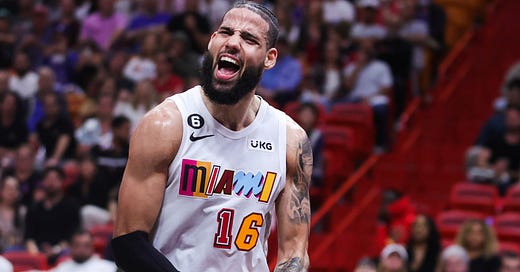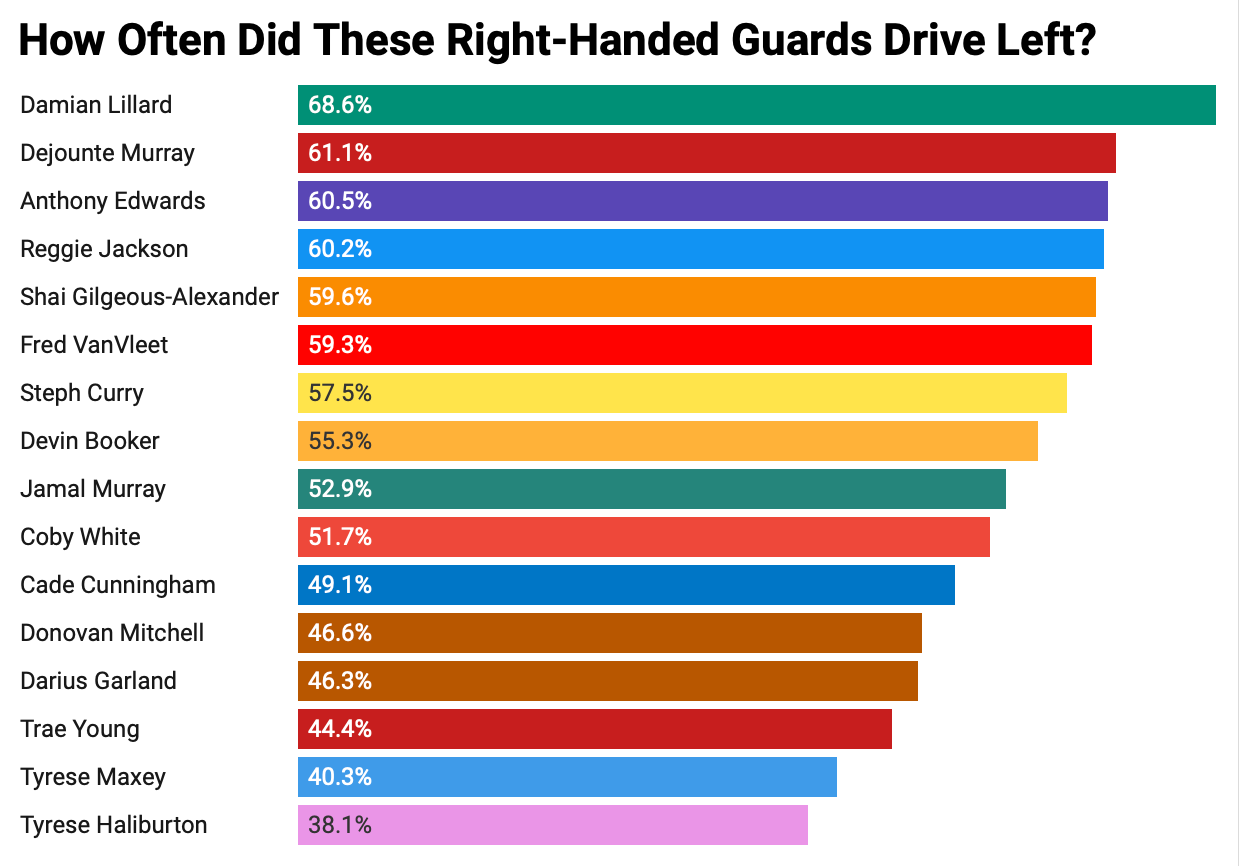One Little Thing Each to Know About Caleb Martin, Andre Drummond and Reggie Jackson
Preseason basketball is almost here.
No matter how much basketball you watch, you never fully understand a player until they’re on your team.
My personal dose of basketball-watching passed the checkpoints of normal and healthy a long time ago, and I even learned something about each of the Sixers’ newcomers once they came on board. I found out that Nico Batum might be the greatest post entry passer of all-time, that Kelly Oubre Jr. is far better at guarding smaller, quicker point guards than he is guarding beefy wings, that Pat Bev is a wildly underrated passer, and so much more. You might feel like you have a total grasp on the NBA and its characters, but you truly don’t have a full picture of each player until you’re watching them with great detail for the next 82 games.
Unless you’ve been living under a rock all summer, you know that the Sixers went through a massive roster overhaul this summer. From superstar max contract signings to bringing in the hero of French Olympic basketball, it’s a whole new team in Philly for 2024-25.
Again, no Sixers’ fan or writer will have the whole picture of each guy here until they’ve played 82 games in Philly, but here are some little quirks that I found in each of their games from watching the tape from their previous teams:
Caleb Martin — Oubre Cutting Impressionist
Almost everything about the Oubre experience last season was a pleasant surprise. One of the quickest things everyone learned was just how valuable it was to have him as a weak side, baseline cutter opposite of Joel Embiid. The Tsunami Papi is 6-foot-7 and a great vertical athlete, giving him the ability to punish opponents with powerful finishes at the rim whenever they titled the shape of their defense toward stopping Embiid with double and triple teams.
Caleb Martin isn’t quite the open floor athlete that Oubre is, but having been molded by Erik Spoelstra’s read-and-react system for the three seasons, he’s become a wily cutter. Should a defender ever ignore Martin in the weak side corner, he’ll slowly sneak behind them into the dunker spot, ready to pounce with a quick finish as a moment’s notice.
In fairness, a large swath of Miami’s cast have become good cutters over the years simply by playing in the Heat’s system, so there’s a tiny chance that Martin isn’t as instinctive a cutter outside of that ecosystem. However, I’d wager that these opportunistic cuts of his don’t fade away, and that he remains a valuable off-ball weapon in Philly.
And while Oubre is almost primarily a baseline cutter, Martin can pull double duty as a slot cutter, knifing through the paint whenever a teammate is cut off near the rim.
It’s almost as if he’s running planned dribble hand-offs with his teammates in the paint, as Martin gathers up momentum in such a short amount of time and attacks the basket downhill. It’s a skill that could pair nicely with someone like Tyrese Maxey, who may be looking to slow down and hit some open passes more often this season, with defenses more worried about how often he attacks the paint.
Instead of just waiting behind the three-point line – where he only hits about 35% of the time – Martin prefers to head toward the basket and punish the defense up close.
Andre Drummond — Master of COOKIES
The most aesthetically pleasing steal in basketball, bar none: An offensive player is sizing the defender up, thinking they’re about to hit a crossover and turn the corner, only to get the ball plucked straight out of their hands. If you’re a true hooper, you shout “COOKIES” in all caps at your TV the moment you see one of these steals happen.
If you don’t want to take my word for it, then hear what Baron Davis had to say:
These types of steals are particularly notable whenever a center pulls it off. For as important as big men are to defense in the game of basketball, they’re not exactly known for ripping a perimeter player clean while they’re dribbling in open space.
That is, unless they’re Andre Drummond, who’s up there as one of the preeminent cookie artists in the entire NBA.
Given that he’s proclaimed himself the greatest offensive rebounder in the sport’s history, it might come as a surprise that Drummond is “only” 6-foot-10 without shoes. He cleans the glass routinely despite not being a true 7-footer. Drummond makes up for it by having a ridiculously strong upper body, surprisingly quick reflexes – and, most importantly, a gargantuan 7-foot-6 wingspan.
It’s those latter two traits that are most often on display in those Drummond clips shown above. Most guards and wings think they have a mismatch when a center steps out to them near the three-point line, but are often caught lacking when the vines attached to Drummond’s upper body extend out and swipe the ball before they even know what happened.
With Tobias taking the Crumbl brand with him to Detroit, I’m predicting Drummond as the foremost master of COOKIES on the 2024-25 Sixers.
Reggie Jackson — (Almost) Always Driving Left
Hand-dominance in basketball is extremely important. At almost any level up until the NBA, there’s a decent chance a defender can turn the offensive player’s water off simply by forcing them to use their weak hand.
But then you get to the NBA, where players are so good that it’s a rarity when they can’t attack to either side with relative ease. One of those guys who’s very comfortable attacking the opposite side of his dominant hand — newest Sixers’ guard Reggie Jackson.
(Drive frequency data pulled from Synergy Sports. Drive directions classified as “straight” were removed so it’s just right vs left drive direction frequency)
One disclaimer in regard to that chart: Synergy only tracks these drives on possessions where each player shot the ball, committed a turnover, or drew a shooting foul. It does not track the direction they drove on possessions where they passed out to a teammate.
Mostly, it’s just notable that Jackson is a righty who quite frequently wants to attack to his left, especially given that his newest backcourt partner Maxey is wired in almost the exact opposite way.
There’s a good reason for this — Maxey, at his core, is a driver. He wants to get to the rim and finish over the defense far more often than he wants to stop short in the mid-range and pull up for a 15-foot jumper. When you’re end-goal is the rim, you more often than not want to attack to the side of hoop that aligns with your dominant hand, as it’s just going to be easier for you to make those acrobatic, in-traffic layups with that hand than it would be with your weak side.
Conversely, if a right-handed player is driving with the express intent of pulling up short of the rim, they’re more often going to the left. I’ll spare you the biomechanical rabbit hole behind why this is the case, but generally speaking, the transition from the dribble to the jumper is easier when the last dribble came from a player’s non-shooting hand. That push shot floater from Jackson in the clips above is one of his trademark moves, and it’s one he almost exclusively goes to while attacking left.
With all three of Maxey, Kyle Lowry, and Eric Gordon likely ahead of Jackson in the backcourt rotation (not to mention the growing potential of Jared McCain), the chances that this is heavily relevant for the Sixers is slim. But should Jackson see some run during this season, expect him to attack the left side of the court way more often than you’d expect from a right-handed guard.
Daniel Olinger is a writer for the Rights To Ricky Sanchez, and author of “The Danny” column, even though he refuses to be called that in person. He can be followed on X @dan_olinger.
“The Danny” is brought to you by the Official Realtor Of The Process, Adam Ksebe.









